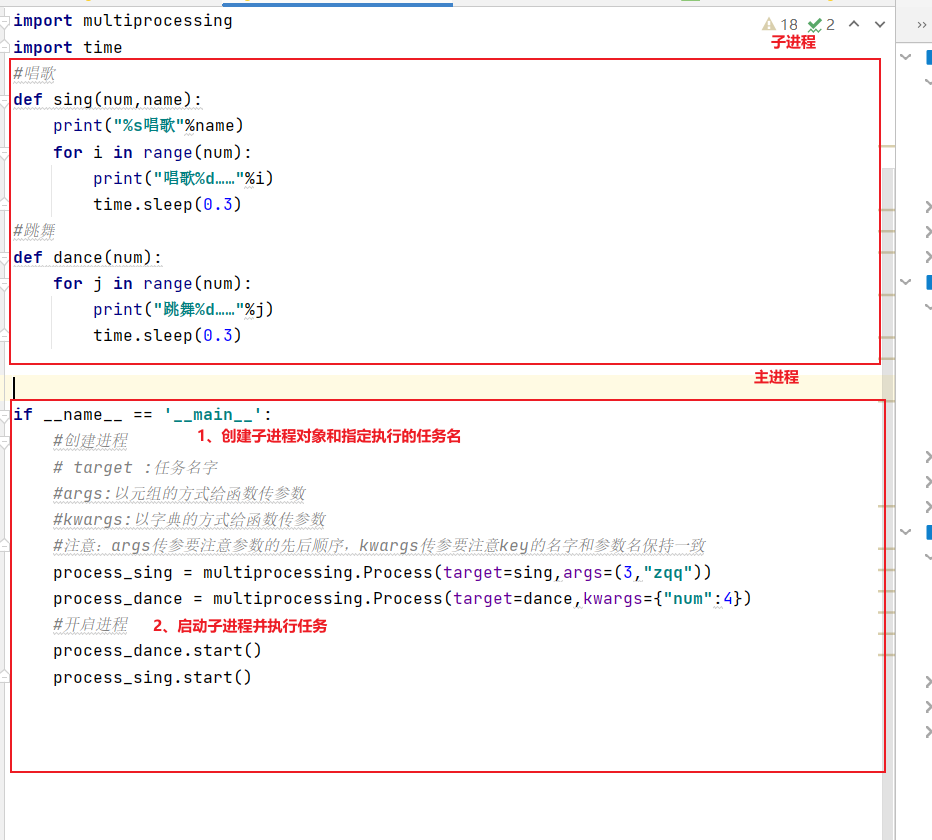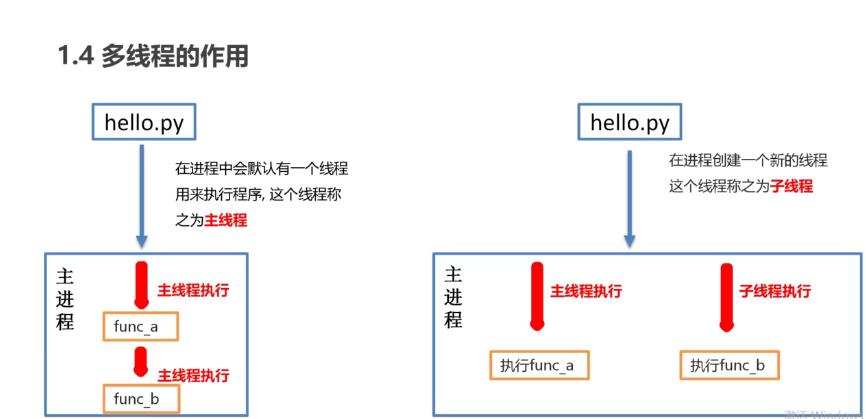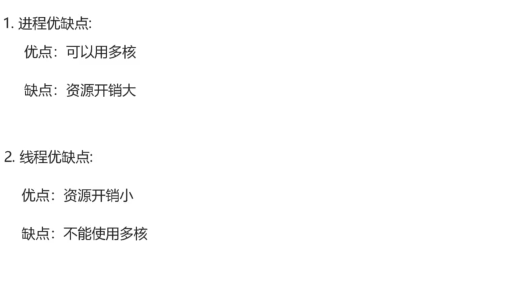python multithreaded programming notes
Information: Video tutorial
Time: August 31, 2021
1, Process
(1) Introduction to multitasking
Multitasking: execute multiple tasks at the same time
Advantages of multitasking: the biggest advantage is to make full use of cpu resources and improve the execution efficiency of programs
Two ways
1. Concurrent

2. Parallel

(2) Introduction to process
Process is the smallest unit of resource allocation. It is the basic unit of resource allocation and scheduling of the operating system (eg: the executing program is a process)
(3) Multi process and multi task
1. Process creation steps
-
Import process package
-
import multiprocessing
-
-
Creating process objects through process classes
-
Process object = multiprocressing.Process(target=Task name)

-
-
Start the process and execute the task
-
Process object.start()
-
#1. Import package
import multiprocessing
import time
def sing():
for i in range(3):
print("Singing")
time.sleep(0.3)
def dance():
for j in range(3):
print("Dance")
time.sleep(0.3)
if __name__ == '__main__':
#2. Create process
process_sing = multiprocessing.Process(target=sing)
process_dance = multiprocessing.Process(target=dance)
#3. Start process
process_dance.start()
process_sing.start()
2. The process executes a task with parameters

Note: for args parameter transmission, pay attention to the sequence of parameters. For kwargs parameter transmission, pay attention to the consistency between key name and parameter name
#Import package
import multiprocessing
import time
def sing(num,name):
print("%s sing"%name)
for i in range(num):
print("sing%d......"%i)
time.sleep(0.3)
def dance(num):
for j in range(num):
print("dance%d......"%j)
time.sleep(0.3)
if __name__ == '__main__':
#Create process
# target: task name
#args: pass parameters to the function as tuples
#kwargs: pass parameters to functions in dictionary mode
#Note: for args parameter transmission, pay attention to the sequence of parameters. For kwargs parameter transmission, pay attention to the consistency between key name and parameter name
process_sing = multiprocessing.Process(target=sing,args=(3,"zqq"))
process_dance = multiprocessing.Process(target=dance,kwargs={"num":4})
#Start process
process_dance.start()
process_sing.start()
(4) . obtain the process number
1. Two ways to get the process number
-
Get current process number
os.getpid()
-
Gets the current parent process number
os.getppid()
2. Method of use
-
Guide Package
import os

#Import package import multiprocessing import time import os #sing def sing(num,name): print("Singing process pid",os.getpid()) #Current process number print("Main process of singing pid",os.getppid()) #Parent process number print("%s sing"%name) for i in range(num): print("sing%d......"%i) time.sleep(0.3) #dance def dance(num): print("The process of dancing pid",os.getpid()) print("Main process of dancing pid",os.getppid()) for j in range(num): print("dance%d......"%j) time.sleep(0.3) if __name__ == '__main__': print("Of the main process pid:%d\n"%os.getpid(),"------"*10) #Create process # target: task name #args: pass parameters to the function as tuples #kwargs: pass parameters to functions in dictionary mode #Note: for args parameter transmission, pay attention to the sequence of parameters. For kwargs parameter transmission, pay attention to the consistency between key name and parameter name process_sing = multiprocessing.Process(target=sing,args=(3,"zqq")) process_dance = multiprocessing.Process(target=dance,kwargs={"num":4}) #Start process process_dance.start() process_sing.start()
(5) . process considerations
1. The main process will wait for the execution of all child processes to end
eg:
import multiprocessing
import time
def work():
for i in range(10):
print("At work")
time.sleep(0.2)
if __name__ == '__main__':
work_process = multiprocessing.Process(target=work())
# work_process.daemon = True
work_process.start()
time.sleep(1)
print("End of main process")
2. Set daemon (main process)
Process object. daemon = True
import multiprocessing
import time
def work():
for i in range(10):
print("At work")
time.sleep(0.2)
if __name__ == '__main__':
work_process = multiprocessing.Process(target=work())
#Start the main thread guard, the main thread ends, and other threads also end
work_process.daemon = True
work_process.start()
time.sleep(1)
print("End of main process")
(6) , multitasking copy manager
1. Demand analysis
- Whether the target folder exists. If it exists, it will not be created. If it does not exist, it will be created
- Traverse all files in the source file and copy to the destination folder
- Multi task is realized by process to complete high concurrent copy
import os
import multiprocessing
def copy_file(file_name,source_dir,dest_dir):
# 1. Splice source folder path and destination folder path
source_path = source_dir+"/"+file_name
dest_path = dest_dir+"/"+file_name
# 2. Open source and destination files
with open(source_path,"rb") as source_file: #Read file contents in rb binary mode
with open(dest_path,"wb") as dest_file: #wb write file contents in binary mode
# 3. Loop reading source file to destination path
while True:
data = source_file.read(1024)
if data:
dest_file.write(data)
else:
break
if __name__ == '__main__':
# 1. Define source files and destination folders
source_dir = r"G:\markdown\python"
dest_dir = r"D:\python"
# 2. Create destination folder
try:
os.mkdir(dest_dir)
except:
print("The target file already exists")
# 3. Read the file list of the source file
file_list = os.listdir(source_dir)
# 4. Traversing the file list to copy
for file_name in file_list:
# copy_file(file_list, source_dir, dest_dir)
# 5. Multi task copy using multi process
process = multiprocessing.Process(target=copy_file,args=(file_name,source_dir,dest_dir))
process.start()
2, Thread
(1) Introduction to threads


(2) . multithreading to complete multitasking
1. Steps to create a thread
-
Import thread module
import threading
-
Create thread object
Thread object = threading.Thread(target = Task name)
-
Start the thread to execute the task
Thread object.start()
import time
import threading
def sing():
for i in range(3):
print("sing:",i)
time.sleep(1) #Rest for 1s
def dance():
for j in range(3):
print("dance:",j)
time.sleep(1)
if __name__ == '__main__':
#sing()
#dance()
#Create thread
sing_thread = threading.Thread(target = sing)
dance_thread = threading.Thread(target = dance)
#Open thread
sing_thread.start()
dance_thread.start()
(3) . the thread executes tasks with parameters

import time
import threading
def sing(num):
for i in range(num):
print("sing:",i)
time.sleep(1) #Rest for 1s
def dance(num):
for j in range(3):
print("dance:",j)
time.sleep(1)
if __name__ == '__main__':
#Create thread
#args: pay attention to the order of parameters when passing parameters to the function. Parameters are tuples
#kwargs: pass in the form of dictionary. Note: the parameter name must be consistent with
sing_thread = threading.Thread(target = sing,args=(3,))
dance_thread = threading.Thread(target = dance,kwargs={"num":3})
#Open thread
sing_thread.start()
dance_thread.start()
(4) End order of, main thread and child thread
The main thread will wait for the execution of all child threads to end before the main thread ends
There are two ways to set up daemons:
-
When creating a thread, add the daemon parameter and set it to True
threading.Thread(target=Task name,daemon=True)
-
Using damon
Thread object.demon = True
import threading
import time
def work():
for i in range(10):
print("At work",i)
time.sleep(0.5)
if __name__ == '__main__':
work_thread = threading.Thread(target=work,daemon=True)
#Method 1: set daemon thread
# work_thread.daemon = True
work_thread.start()
time.sleep(4)
print("Main thread end")
(5) Execution order between threads
The order of execution between threads is out of order
-
Get the current thread information through current_thread method
#Through current_thread() get thread current_thread = threading.current_thread() #Print print(current_thread)
import threading import time def task(): time.sleep(1) thread = threading.current_thread() print(thread) if __name__ == '__main__': for i in range(5): sub_thread = threading.Thread(target=task) sub_thread.start() #Execution is out of order
(6) Comparison of, process and thread
- Relationship comparison
- Threads are attached to processes. Without processes, there are no threads
- A process provides one thread by default, and a process can create multiple threads

-
Difference comparison
- The resource cost of creating a process is greater than that of creating a thread
- Process is the basic unit of operating system resource allocation, and thread is the basic unit of cpu scheduling
- Threads cannot be executed alone and must exist in the process
-
Advantages and disadvantages

(7) , multi process and highly concurrent copy
import os
import threading
def copy_file(file_name,source_dir,dest_dir):
# 1. Splice source folder path and destination folder path
source_path = source_dir+"/"+file_name
dest_path = dest_dir+"/"+file_name
# 2. Open source and destination files
with open(source_path,"rb") as source_file: #Read file contents in rb binary mode
with open(dest_path,"wb") as dest_file: #wb write file contents in binary mode
# 3. Loop reading source file to destination path
while True:
data = source_file.read(1024)
if data:
dest_file.write(data)
else:
break
if __name__ == '__main__':
# 1. Define source files and destination folders
source_dir = r"G:\markdown\python"
dest_dir = r"D:\python"
# 2. Create destination folder
try:
os.mkdir(dest_dir)
except:
print("The target file already exists")
# 3. Read the file list of the source file
file_list = os.listdir(source_dir)
# 4. Traversing the file list to copy
for file_name in file_list:
thread = threading.Thread(target=copy_file,args=(file_name,source_dir,dest_dir))
thread.start()